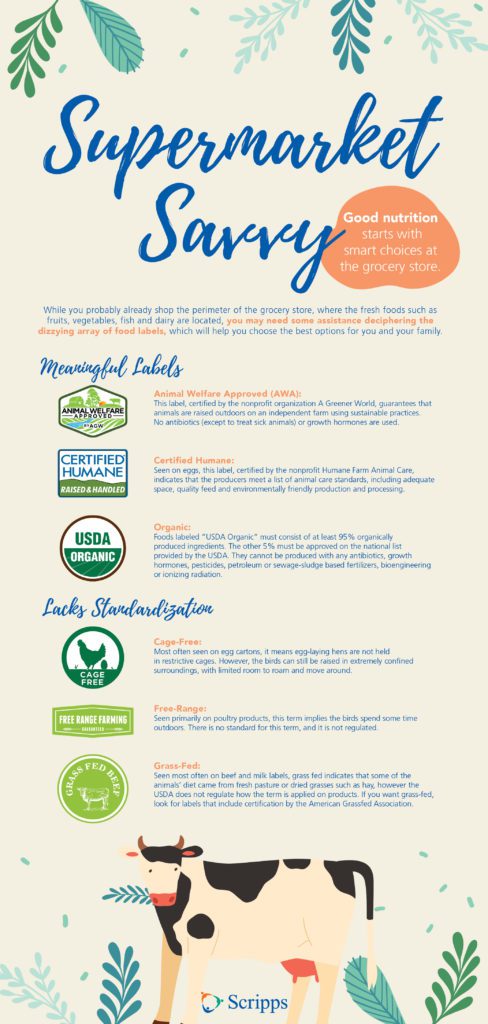
The labels on different foods tell a story, but few of us as moms know how to read them properly. They contain far more information than just ingredients; they also indicate sourcing, preparation, the level of processing, etc.
We wanted some help with this issue to make grocery shopping a much easier and less confusing task, so we reached out to Scripps Health for assistance. They provided us with this helpful breakdown.
In recent years, the FDA has become more stringent about nutrition labels, including making the information easier to read and understand, and being realistic about serving sizes. As a result, it’s easier for shoppers to see how nutritious a food really is.
However, some claims are still not clearly defined. Increasingly, consumers try to avoid substances, such as antibiotics, added hormones and artificial products in their foods. Moreover, many want to ensure that the animals producing their eggs, meat and dairy are humanely treated.
“These concerns have led to more labeling on foods, especially animal products,” says Dana Vaccari, MD, an internal medicine physician at Scripps Clinic Torrey Pines. “However, many of the claims being made are focused more on marketing than health, and they can be misleading.”
Use the information below to help read between the lines and understand what these food labels really mean.

Nutrition claims
Organic
Organic” means that a food is produced without antibiotics, growth hormones, pesticides, petroleum-based fertilizers, bioengineering or artificial ingredients. The U.S. Department of Agriculture (USDA) strictly regulates organic product labeling and requires annual inspections to maintain organic certification. Foods labeled “USDA Organic” must contain at least 95 percent organically produced ingredients. The remaining 5 percent must be on the USDA’s approved national list of ingredients; for example, yogurt may contain enzymes. Foods labeled “made with organic [ingredient]” contain at least 70 percent organically produced ingredients.
Natural
“Natural” is mostly a marketing term that doesn’t tell you much about a food. While natural foods may be free of artificial ingredients, they may have antibiotics, growth hormones and other substances.
Gluten-free
“Gluten-free” has become a popular marketing term – so much so that manufacturers put it on naturally gluten-free foods, such as chicken or brown rice. If you avoid gluten, don’t pay more for “gluten-free” products that never contained gluten in the first place.
Multigrain
“This sounds healthy and means a variety of grains were used, but it does not necessarily mean those grains are ideal,” says Dr. Vaccari. “Some may be enriched or refined. Look for whole grains as the first ingredient.”
Animal welfare claims
Cage-free
This is a common claim on egg cartons, and it can be deceptive. Many companies keep hens in small, crowded cages. While “cage-free” means that the hens are not kept in restrictive cages, they may still be confined to extremely small or crowded areas with very little room to move freely.
Free-range
Most often seen on chicken products, “free-range” suggests that the birds roam outdoors. However, the government does not regulate this term, so there are no standards set for how much time the birds actually spend outdoors or under what conditions.
Pasture-raised
Similar to “free-range” but often seen on products from cows and pigs as well as poultry, “pasture-raised” indicates that the animals have some access to pastures — but no government agencies regulate this claim. In the US, the majority of dairy cows and beef cattle are raised indoors or on outdoor feedlots and fed a diet high in grains, especially corn.
Grass-fed
“Grass-fed” means that the diet includes fresh grass or dried grass, such as hay, but there is no standard for how much of the diet is grass. The USDA does not regulate how this label is used.
Certifications to trust
If buying food produced only by grass-fed or humanely raised animals is important to you, look for these certifications on the packaging.
Certified Humane
This label from the Humane Farm Animal Care, a nonprofit organization, certifies that the producers meet animal care standards, including adequate space, quality feed and environmentally friendly production.
American Grassfed Association or AGW
This certifies that the animals are raised on a pasture and eat grass and other plants without any grains.
Animal Welfare Approved (AWA)
The nonprofit organization A Greener World uses this certification to guarantee that animals are raised outdoors on an independent farm using sustainable practices. The animals receive no growth hormones or antibiotics unless needed to treat illness.
About Scripps Health
Scripps Health is a leading private, non-profit, integrated health system in San Diego, Calif., that treats more than 700,000 patients every year. With five hospital campuses across San Diego County, along with our many outpatient centers, walk-in clinics, emergency rooms, urgent care sites, home-based healthcare and more, we’re dedicated to delivering excellent care whenever and wherever it’s needed. Whether you’re looking for some of the best doctors in San Diego or need care at one of the nation’s best hospitals ranked by U.S. News & World Report, Scripps offers excellent medical care as well as preventive services and wellness screenings for every stage of life.

















